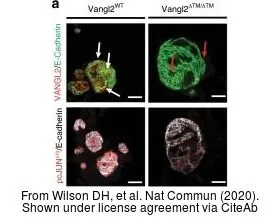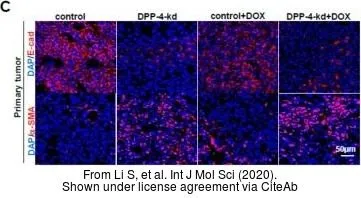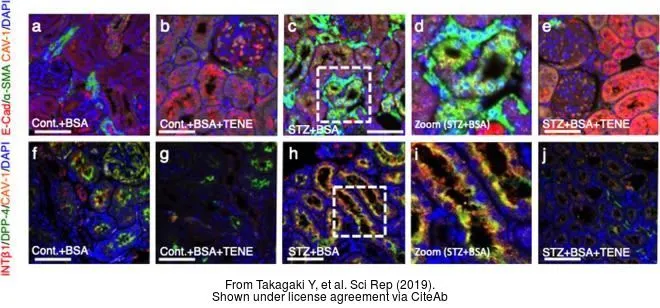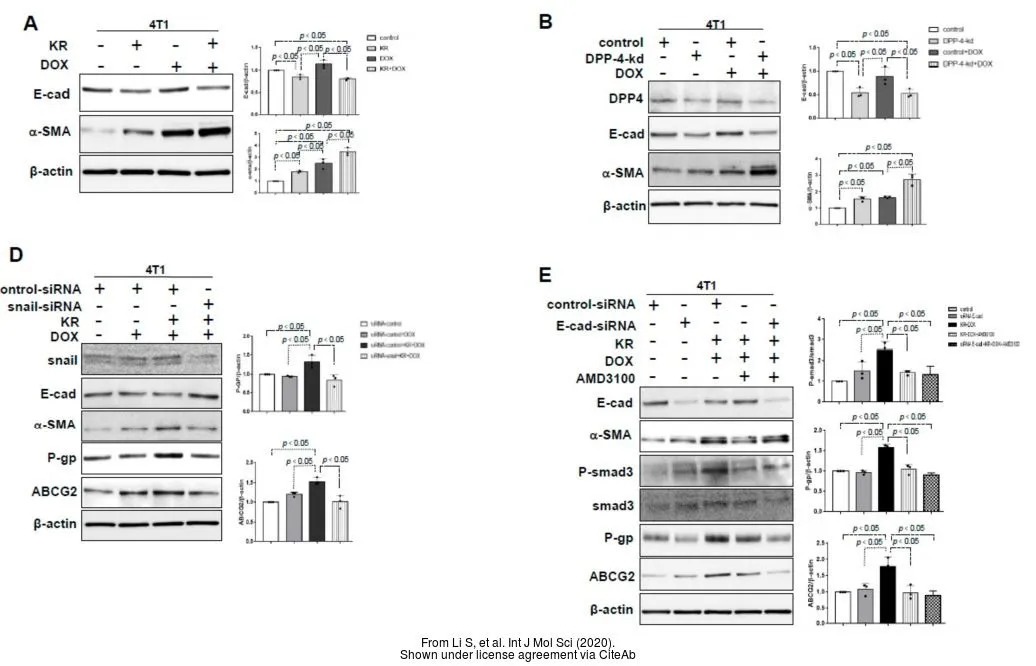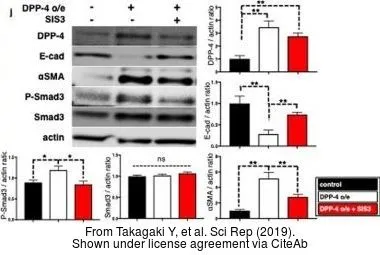![ICC/IF analysis of MDCK cells using GTX11512 E-Cadherin antibody [DECMA-1] at 1:3200. Cells were fixed and permeabilized with methanol followed by acetone. ICC/IF analysis of MDCK cells using GTX11512 E-Cadherin antibody [DECMA-1] at 1:3200. Cells were fixed and permeabilized with methanol followed by acetone.](https://www.genetex.com/upload/website/prouct_img/normal/GTX11512/GTX11512_20170605_ICCIF_1_w_23060519_526.webp)
ICC/IF analysis of MDCK cells using GTX11512 E-Cadherin antibody [DECMA-1] at 1:3200. Cells were fixed and permeabilized with methanol followed by acetone.
E-Cadherin antibody [DECMA-1]
GTX11512
ApplicationsImmunoFluorescence, ImmunoPrecipitation, Western Blot, ImmunoCytoChemistry, ImmunoHistoChemistry, ImmunoHistoChemistry Frozen, ImmunoHistoChemistry Paraffin
Product group Antibodies
ReactivityBovine, Canine, Human, Mouse
TargetCdh1
Overview
- SupplierGeneTex
- Product NameE-Cadherin antibody [DECMA-1]
- Delivery Days Customer9
- Application Supplier NoteICC/IF: 1:1,600. *Optimal dilutions/concentrations should be determined by the researcher.Not tested in other applications.
- ApplicationsImmunoFluorescence, ImmunoPrecipitation, Western Blot, ImmunoCytoChemistry, ImmunoHistoChemistry, ImmunoHistoChemistry Frozen, ImmunoHistoChemistry Paraffin
- CertificationResearch Use Only
- ClonalityMonoclonal
- Clone IDDECMA-1
- ConjugateUnconjugated
- Gene ID12550
- Target nameCdh1
- Target descriptioncadherin 1
- Target synonymsARC-1, E-cad, Ecad, L-CAM, UVO, Um, cadherin-1, E-cadherin, epithelial cadherin, uvomorulin
- HostRat
- IsotypeIgG1
- Protein IDP09803
- Protein NameCadherin-1
- Scientific DescriptionCell-cell interactions during embryonic development and in tissue organization involve specific cell-adhesion molecules (CAMs) that are functionally defined by antibodies that interfere with cell-cell adhesion. CAMs are expressed on early embryonic cells and persist in derivatives of all three germ layers. The best characterized CAMs are N-CAM (neural CAM) and L-CAM (liver CAM). The protein Uvomorulin, initially identified in embryonal carcinoma, is identical to L-CAM, E-Cadherin, Cell CAM 80/120 and ARC-1, each of which have been characterized in different systems. E-Cadherin has been characterized as a 120 kDa cell surface glycoprotein from which an 84 kDa fragment can be released by trypsin digestion in the presence of Ca2+.
- ReactivityBovine, Canine, Human, Mouse
- Storage Instruction-20°C or -80°C,2°C to 8°C
- UNSPSC12352203
References
- Monster JL, Donker L, Vliem MJ, et al. An asymmetric junctional mechanoresponse coordinates mitotic rounding with epithelial integrity. J Cell Biol. 2021,220(5). doi: 10.1083/jcb.202001042Read this paper
- Li J, Liu H, Takagi S, et al. Renal protective effects of empagliflozin via inhibition of EMT and aberrant glycolysis in proximal tubules. JCI Insight. 2020,5(6):pii: 129034. doi: 10.1172/jci.insight.129034.Read this paper
- Li S, Fan Y, Kumagai A, et al. Deficiency in Dipeptidyl Peptidase-4 Promotes Chemoresistance through the CXCL12/CXCR4/mTOR/TGFβ Signaling Pathway in Breast Cancer Cells. Int J Mol Sci. 2020,21(3). doi: 10.3390/ijms21030805Read this paper
- Wilson DH, Jarman EJ, Mellin RP, et al. Non-canonical Wnt signalling regulates scarring in biliary disease via the planar cell polarity receptors. Nat Commun. 2020,11(1):445. doi: 10.1038/s41467-020-14283-3Read this paper
- Takagaki Y, Shi S, Katoh M, et al. Dipeptidyl peptidase-4 plays a pathogenic role in BSA-induced kidney injury in diabetic mice. Sci Rep. 2019,9(1):7519. doi: 10.1038/s41598-019-43730-5Read this paper
- Hart KC, Tan J, Siemers KA, et al. E-cadherin and LGN align epithelial cell divisions with tissue tension independently of cell shape. Proc Natl Acad Sci U S A. 2017,114(29):E5845-E5853. doi: 10.1073/pnas.1701703114Read this paper
- Gloerich M, Bianchini JM, Siemers KA, et al. Cell division orientation is coupled to cell-cell adhesion by the E-cadherin/LGN complex. Nat Commun. 2017,8:13996. doi: 10.1038/ncomms13996Read this paper
- Cheng F, Shen Y, Mohanasundaram P, et al. Vimentin coordinates fibroblast proliferation and keratinocyte differentiation in wound healing via TGF-β-Slug signaling. Proc Natl Acad Sci U S A. 2016,113(30):E4320-7. doi: 10.1073/pnas.1519197113Read this paper
- Peppicelli S, Bianchini F, Torre E, et al. Contribution of acidic melanoma cells undergoing epithelial-to-mesenchymal transition to aggressiveness of non-acidic melanoma cells. Clin Exp Metastasis. 2014,31(4):423-33. doi: 10.1007/s10585-014-9637-6Read this paper

![ICC/IF analysis of MDCK cells using GTX11512 E-Cadherin antibody [DECMA-1] at 1:3,200. Cells were fixed and permeabilized with cold methanol followed by acetone. ICC/IF analysis of MDCK cells using GTX11512 E-Cadherin antibody [DECMA-1] at 1:3,200. Cells were fixed and permeabilized with cold methanol followed by acetone.](https://www.genetex.com/upload/website/prouct_img/normal/GTX11512/GTX11512_20170605_ICCIF_w_23060519_834.webp)
![WB analysis of MDCK cells using GTX11512 E-Cadherin antibody [DECMA-1] at 1:250. WB analysis of MDCK cells using GTX11512 E-Cadherin antibody [DECMA-1] at 1:250.](https://www.genetex.com/upload/website/prouct_img/normal/GTX11512/GTX11512_20170605_WB_w_23060519_640.webp)
